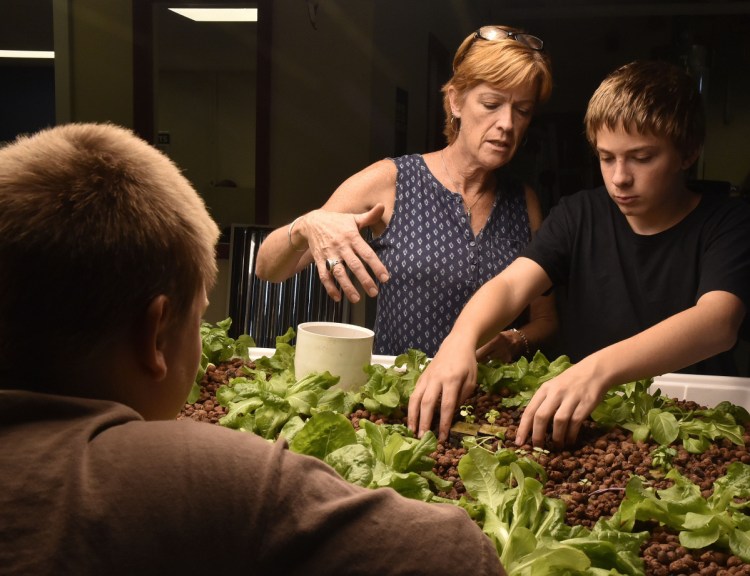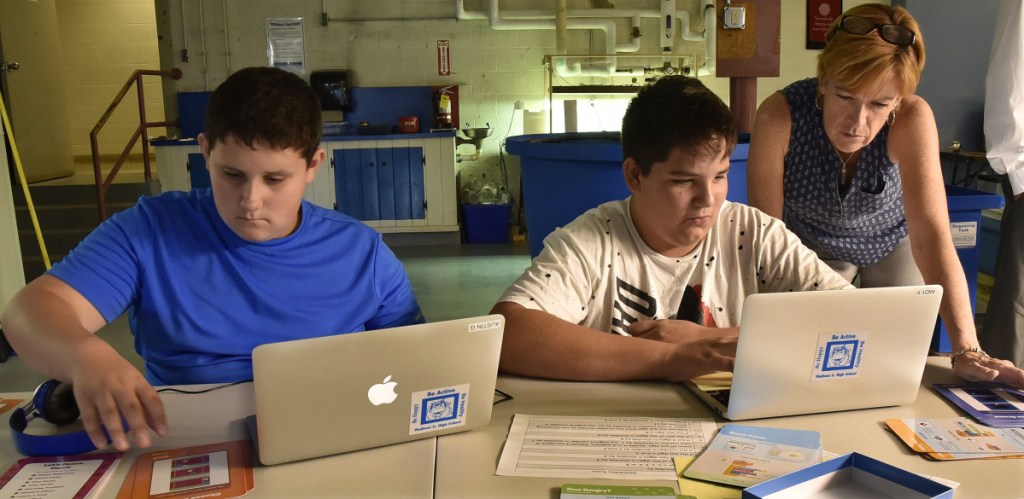MADISON — The large room at the back of Madison Junior High School has been used for a lot of things over the years.
It was used for shop class. It was the “drama closet.” The band room.
Now, with computers, a full kitchen, video equipment, desks, couches and ongoing aquaponics projects, the room is a place school officials hope will become a pathway to academic achievement and careers after graduation.
“It’s problem based, not project based,” junior high principal Ryan Arnold said of the alternative education program called Kennebec Valley Multiple Pathways Academy.
It’s a collaboration for middle school students from the Madison, Carrabec and Bingham school districts developed with the help of a $300,000 grant through the state Department of Education.
As of last week, there were just five participating students, but that’s about to change, said Julie Wallace, the classroom teacher.
“If we’re doing a good job, community businesses will come to us and say: ‘Who do you have? I’ve got these spots open and I know you have great workers. I know your kids have critical thinking skills and can problem solve. Who do you have for me?'” Wallace said. “These guys are leaving with a resume. They’ve run an aquaponics business. They’ve worked out here with citizen-science projects. They’ve run a school store. They’ve got business management experience.
“I’m very excited about where it’s going to go.”
Wallace said students already are working with John Harlow, station manager at Somerset Community TV 11, a cable television station serving Madison, Skowhegan and Anson, and with the state Department of Inland Fisheries & Wildlife on a bird count project.
Wallace and Arnold said the students will continue with their regular course of studies, including integrating math, language arts and the other classes typical of a middle school or high school curriculum, they just will be learning in a different way.
Students in the class said that’s the way they learn best, anyway.
Aiden Taylor, a seventh-grader from Anson, said he likes the hands-on approach to his school work.
“I think it’s pretty good,” he said of the program. “For me, I’m not one of those kids who learns by sitting in a classroom and reading a book. I want to be able to walk around, doing stuff, and I think this is a really good program for kids like that, like me.”
Aiden said he is learning from working with the aquaponic projects, raising lettuce and other leafy green vegetables and herbs, testing the water and knowing how and when to tend to the plants for sustained growth.
Aquaponics is the combination of aquaculture — raising fish — and hydroponics — the soil-less growing of plants — that grows fish and plants together in one integrated system. The fish waste provides an organic food source for the plants, and the plants naturally filter the water for the fish.
Austin Gross, 13, of Skowhegan, agreed with his classmate, saying it’s more about actually doing something than reading about doing something.
“It’s pretty good. It helps me learn a lot better,” he said. “It’s more hands-on rather than from a piece of paper.”
Dusty Corson, another seventh-grader from Solon, said he is glad he enrolled in the program at the start of classes this year.
“I like it. It’s a lot better than regular school,” he said. “It’s more hands-on.”

Students Dusty Corson, left, and Aiden Taylor, both of Carrabec High School, pick over plants in an aquaponics project at Madison Junior High School in an alternative education class on Thursday.
Wallace said working with the local cable-TV station, which has offices and studios in Madison, has been helpful.
“They have high school students working with them now, doing some videography stuff, and I have a couple of students here that are really interested in that, so they have agreed to allow, when our students are ready, to mentor with the high school students that are working there,” she said.
Wallace said she would like to establish a feeder program to fill the needs at the television station, filming and editing, as students move on after graduation. The Pathway classroom already has a video production station set up so the students can learn software including Final Cut Pro and make their own video. They also have a drone program, and the students using math and physics have already made a video using the drone, she said.
“The drones are showing the students what they are going to see in their future careers and how drones are being implemented into careers,” she said.
They also have a culinary arts program called Cooking Matters, with a chef coming in for instruction once a week for six weeks and a focus on nutrition and learning how to prepare meals. Students also will learn how to manage a food cupboard and the business administration and economics of running a school store. They also will learn construction and drafting skills, woodworking and automotive maintenance using the school’s own transport van.
Other projects include a program to develop work ethics and team building to gain independence and to show their ability to handle responsibility. Students will be assigned multiple “jobs” and will create a resume with real work experience, Wallace said.
As in regular classroom work, students will focus on the district’s proficiency-based curriculum, but with an eye on career exploration and redefining the meaning of school, according to Wallace.
“If it were me, this is how I would deliver school to everyone,” Wallace said. “Because I feel this is the best way to learn — learning while you’re practicing career skills. This is making vocational, entrepreneurialship, career exploration part of your every day.
“It’s the same standards, the same premise, but we’re doing it on the fly.”
Doug Harlow — 612-2367
Twitter:@Doug_Harlow
Send questions/comments to the editors.




